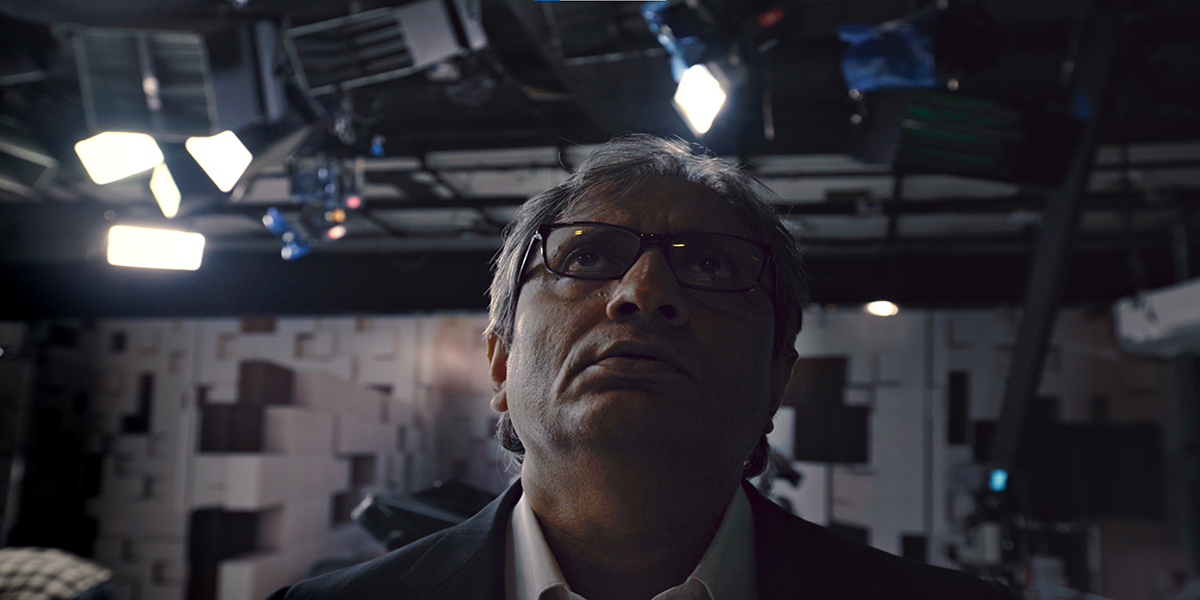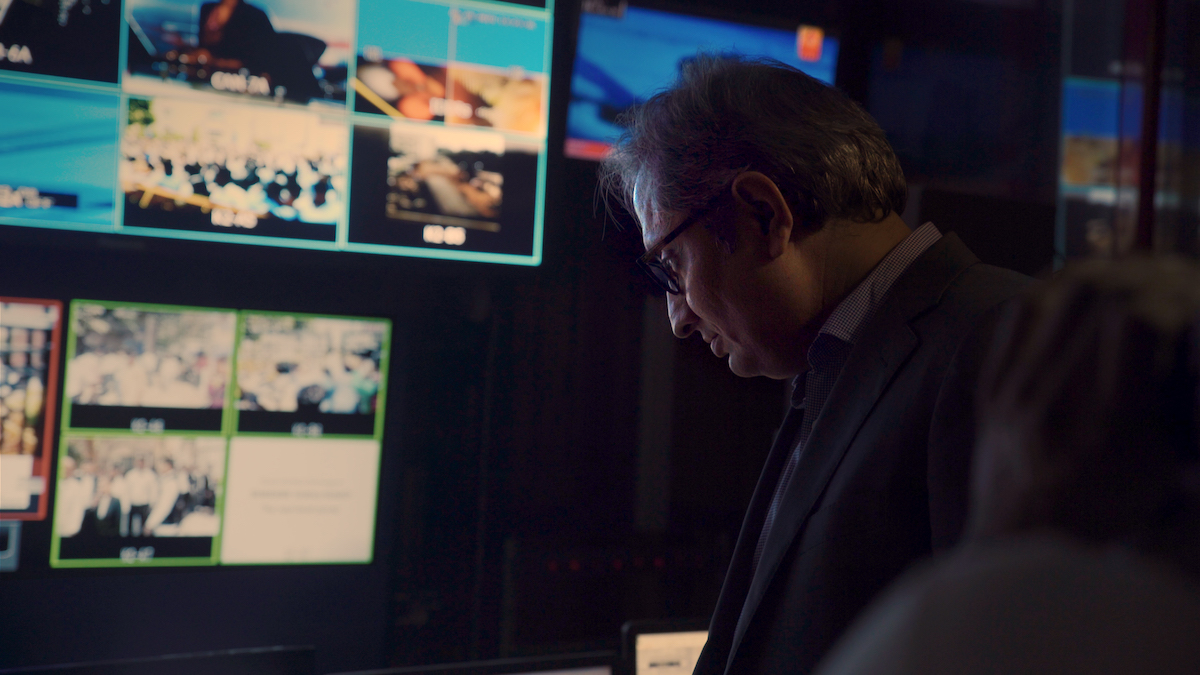Vinay Shukla’s dignified character study is a poignant testament to the arduous task of protecting journalistic ethics, integrity and a code of conduct from becoming obsolete, in-between widespread misinformation and disinformation practices. Following the life, activities, work and choices that investigative journalist and news presenter Ravish Kumar makes, the film appropriates a sophisticated day-in-the-life-of style, to depict the legacy of one of the most celebrated Indian journalists.
With the focus being placed on Kumar, the film illustrates how his presence and legacy influences, informs or impacts different environments around him, in a compelling exploration of the choices we make about the types of information we accept as truth, the ways in which we express our perception of truth, and we reconcile -or not as the case may be, mutually dependant or excluding types of inconvenient truths While We Watch in situated environments. With the onus of these choices being placed on spectator-citizens, the crux of the matter is essentially an expression of self-censorship; the extent to which both spectator-citizens and journalists alike, decide to welcome it or not for fear of being misjudged, excluded or even ostracised from the environments they participate in.
This dilemma seems to be the beating heart of the film, expressed in a rhythmically captivating, thought-provoking visual symphony. Its sound is being discreetly dispersed and eventually muffled in-between ringing phones, nervous voices, short pauses before important information is communicated, spontaneous expressions of appreciation and the sound of fidgety fingers on keyboards making their presence felt briefly, only to re-appear as a response to news broadcasts and in-between conversations. Its visual articulation skilfully emerges through Abhinav Tyagi’s sophisticated editing which seems to combine, gently but attentively, two complementary rhythms; a measured, tentative pace comprising slow transitions collated frame-by-frame through close-ups and medium shots, and a faster-paced, spontaneous arrangement of visually arresting images, courtesy of cinematographer Amaan Shaikh, rushing from the hand-held camera and busy newsroom onto the big screen with a sense of urgency. Employing an interesting combination of tenderness, humility, and fact-checked objectivity, making confirmation bias and self-censorship or the absence thereof its focal point, the film comprises an interesting aesthetic melange of citizen journalism and a nuanced biographical documentary, which is well worth watching.

The film’s intention to interweave the aesthetics of a tender video homage, “a love letter to journalism” as it were, with the feel and powerful testimony of citizen journalism, requires a fine balance which seems difficult to achieve at times but exudes an alluringly organic look and feel when it is indeed successfully manifested. A hand-held camera follows Kumar’s brisk walk down the corridor of the busy newsroom. The bustling space is filled with the voices of his colleagues on the phone, checking facts before broadcast, communicating intensely with one another at the editing suite. The energetic, spontaneous camera movements following Kumar’s interactions with his colleagues and the latter’s reflections on what they see on their TV monitors, editing screens, mobile phones, are juxtaposed with intermittent static images of talking heads on TV and computer screens, creating a rhythmic choreography which feels simultaneously up-close and personal, but also distant and observational. Their spontaneous but measured responses to what they see, their organic verbal and non-verbal interactions with Kumar- live testimony of them having worked as a tight-knit group for quite some time is in direct contrast with the abrasively impassionate orators appearing on screen, launching attacks against people holding opposing views, and organisations who do not support the dominant ideology or political beliefs. While this contrast could have been used as the main focus of the film, Shukla’s work moves past the ubiquitous discussion of misinformation and disinformation power dynamics to depict how these opposing views come to create certain environments; the process in which particular ideas or approaches become conceptualised or have the potential to create forms of what I can personally approach as a form of real-time making of certain formulations of “situated knowledges” (Harraway, 1988). Who talks and why, whose opinion comes to be considered as truth and in which context, whose opinion is considered to matter and whose is decidedly excluded. What happens in the daily lives of those who have to endure a process of being silenced or stripped of their critical thinking. This is the heart of the film and, in my opinion, a compelling contribution to the global political discourse of recent years, around the widespread adoption of sensationalist news agendas and possible ways to counteract them.
Prime time news presenter Ravish Kumar acts as a journalistic class hero, as it were, carrying himself with the confidence, sense of duty and self-respect which the long-term dedication to the noble cause of serving people with information sourced responsibly, has instilled in him. Devoted to the principles of thorough, fact-based research and impartiality, Kumar makes a conscious choice to do the right thing every day, with his journalistic practice acting as a much-needed masterclass in a post-truth, post-journalism era, fuelled by alt-right sentiment. Rather than taking on a full-time role of a missionary fighting against disinformation practices that have plagued journalism and global societies more broadly, Kumar’s character seems to be more focused on its effects; the slow disintegration of critical thinking, the breakdown of spectator-citizens’ empowerment and confidence to respectfully stand-up for what they believe in, and last but not least, the skewed ideas of what journalism is and what it is supposed to do; misconceptions that have eroded both journalists’ and spectators’ understanding of the principles that professional journalism has set out to serve.
Nothing could have been significant enough to make Kumar reflect momentarily on his default status as a staunch supporter of ethical, impartial, and quality investigative journalistic research, if it weren’t for the anonymous calls and death threats, he receives daily, by self-proclaimed righteous figurations-as-responsible-citizens, conceptualising and enforcing the dominant political ideology that deems him as a persona non grata. His buzzing smartphone constantly intercepts peaceful family moments, social gatherings and celebrations, quiet time, and work deadlines in equal measures, with tension building up, anxiety slowly creeping in and putting a strain on his relationship with others. The frequency in which farewell cakes are being presented by departing colleagues, the uneasiness which settles and permanently resides in Kumar’s home, the assignment of police protection to him and his family members, lead to a point of no return. Yet, rather than giving up, Kumar continues to stand up for what he believes in and surreptitiously takes back the power by transforming the negative culmination of events to a possibility for alternative socio-political imaginaries. In one of the most tender and emotionally charged scenes in the film, Kumar decides to reverse the impact of another bout of verbal attacks he receives on the phone and make it a meaningful moment shared with his family. Putting his mobile phone on speaker mode, he defends himself by singing a well-loved, traditional song to his abuser, maintaining his calmness, dignity and composure throughout a sequence that crystallises the nuanced, beautifully portrayed journey of his character.

While focusing on the work and legacy of Kumar, the film offers alternative entry points to the effects of widespread disinformation, in such a delicate way that essentially presents what can be thought of as discreet, multiple character studies in-the-make. Kumar’s family members and long-term colleagues sustain and eventually break under the impact of the orchestrated attacks against him. His wife, a prominent academic, has to change her itinerary and daily commute after realising she is being followed on her way to campus. His colleagues have no option but to resign and take on roles in other broadcasters, after severe budgetary cuts in the media organisation they had been working at, as it is now considered a news outlet dangerous for the dominant ideology and public. His children have no option but to experience a constant murmur of the sharp, high-pitched sound of a mobile phone as a domestic soundtrack. Through Kumar’s interactions with his colleagues, family members, or even his audience, we get a glimpse of how they form their views, take a stance, and respond to the predicament they find themselves in. There is a scene at a university amphitheatre, which is perhaps simultaneously one of the most alluring and uncomfortable ones, encapsulating the essence of the film. Kumar is invited to give a talk to young students, and openly expresses his views on freedom of speech, when the respondent professor anxiously interrupts him to challenge his argument, stating with conviction that it makes for a highly subjective and questionable approach. It is the close-up of her face during Kumar’s reply, that really makes the sequence one of the most treasured ones in the film. Her teary eyes, her just about stable body posture and trembling voice stand as a testament to a battle she has to win every day. Just like many others, she needs to monitor what she says in public and what she might accidentally reveal as her line of thinking; an act of self-censorship as self-preservation.
An endearing film through and through, the documentary makes a substantial contribution to the widespread debate of recent years around sensationalist news agendas, misinformation and disinformation practices and a potential conceptualisation of modes to counteract them. Riding the fine line between instinctive action and measured consideration, the film subtly encourages spectators to pause, ponder, empathise, question, disapprove and choose the position that they feel most drawn to, or imagine how might be formulated and look like, in case it is not already depicted in the film. In this refined way, Shukla steers clear from any potential didactic attempts and extends an honest invitation to spectators to draw on their own personal notion of citizenship, as well as all the many different shades of self-censorship they might potentially encounter in their day-to-day activities, in order to identify the iterations of self-censorship depicted, their effects and potential ways of counteracting them. At the same time, the sophisticated depiction of Ravish Kumar and his inspirational work make for a gem of a character study in a documentary film.
Shukla’s film stands out for conveying the message of possible alternative futures, starting in the present moment – a point of realisation of the state of affairs, in a way that feels nuanced, personal and political, rather than detached and observational. Rather than making the production and dissemination of disinformation, misinformation narratives and their counter-narratives the focal point of his film, Shukla uses it as his premise to develop a sophisticated angle on the effects of this ongoing battle and the possibility of more open, democratic and egalitarian societies which are being conceptualised and potentially manifested through quotidian decisions and actions.
By Eirini Nikopoulou
While We Watched (2022)
Writer, Director: Vinay Shukla
Language: Hindi
Runtime: 95 Minutes
Editor: Abhinav Tyagi
Cinematography: Amaan Shaikh
